
Huntsman spiders, members of the family Sparassidae, are known by this name because of their speed and mode of hunting. They are also called giant crab spiders because of their size and appearance. Larger species sometimes are referred to as wood spiders, because of their preference for woody places. In southern Africa the genus Palystes are known as rain spiders or lizard-eating spiders. Commonly, they are confused with baboon spiders from the Mygalomorphae infraorder, which are not closely related.

Opisthoncus is a genus of South Pacific jumping spiders that was first described by Ludwig Carl Christian Koch in 1880. There are still many Australian species that have not yet been described.

Heteropoda is a genus of spiders in the family Sparassidae, the huntsman spiders. They are mainly distributed in tropical Asia and Australia, while at least one species, H. venatoria, has a cosmopolitan distribution, and H. variegata occurs in the Mediterranean.
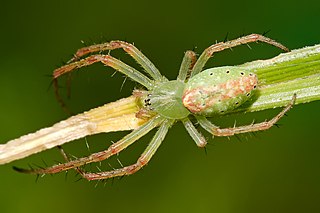
Cyrtophora, the tent-web spiders, is a genus of orb-weaver spiders first described by Eugène Simon in 1895. Although they are in the "orb weaver" family, they do not build orb webs. Their tent-like, highly complex non-sticky web is sometimes considered a precursor of the simplified orb web. These webs are aligned horizontally, with a network of supporting threads above them. These spiders often live in colonies. Females have a body length of mostly about 10 millimetres (0.39 in) long. Some members, including Cyrtophora cicatrosa, exhibit the ability to change colour rapidly.

The giant huntsman spider is a species of the huntsman spider family Sparassidae found in Laos. It is considered the world's largest spider by leg span, which can reach up to 30 cm (1 ft).

Arkys, also known as triangular spider or ambush spider, is a genus of Australian araneomorph spiders in the family Arkyidae, first described by Charles Athanase Walckenaer in 1837. They are often small, with a triangular shaped abdomen, and are found in Australia and some of its surrounding islands. They don't build webs, but can often be found on leaves and tips of flower heads. Their egg sacs are pinkish-orange and spherical, and are made late in the summer.

Holconia is a genus of Southern Pacific huntsman spiders that was first described by Tamerlan Dahls Thorell in 1877. It was branched from Isopeda in 1990.

Isopeda is a genus of huntsman spiders that was first described by Ludwig Carl Christian Koch in 1875.
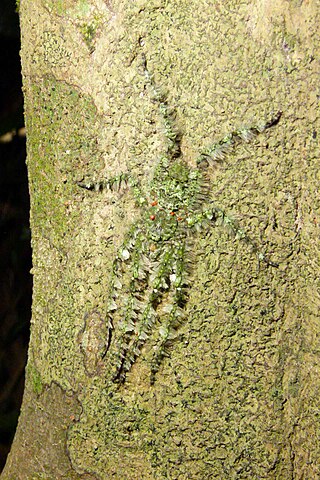
Pandercetes is a genus of huntsman spiders that was first described by Ludwig Carl Christian Koch in his 1875 treatise on Australian spiders. They are mainly distributed in tropical Asia and Australia, and are known for their cryptic coloration that matches local moss and lichen. Their legs have lateral hairs, giving them a feathery appearance, further masking their outline against tree trunks. Their head is somewhat elevated and the carapace has the thoracic region low and flat.

Hemicloea is a genus of South Pacific flat spiders that was first described by Tamerlan Thorell in 1870. Originally placed with the ground spiders, it was moved to the Trochanteriidae in 2018.
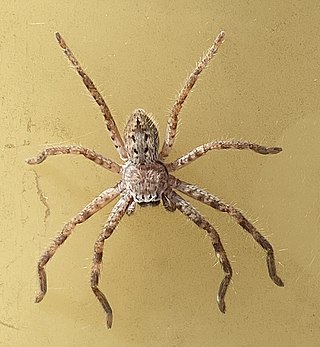
Isopedella is a genus of huntsman spiders that was first described by D. B. Hirst in 1990.

Neosparassus is a genus of huntsman spiders first described by Henry Roughton Hogg in 1903. Members of this genus most closely resemble those of Heteropoda, except that the cephalothorax is high, peaking between the midpoint and the eyes, before sloping toward the back. This angle causes the front of these spiders to appear more prominent than it actually is.
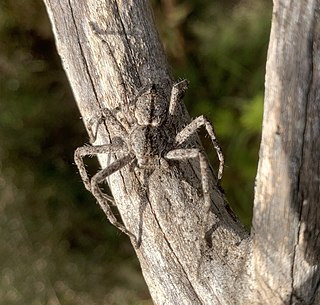
Pediana is a genus of huntsman spiders that was first described by Eugène Louis Simon in 1880.
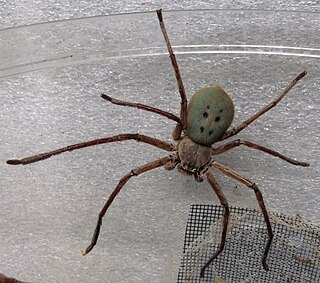
Typostola is a genus of South Pacific huntsman spiders that was first described by Eugène Louis Simon in 1897.
Zachria is a genus of Australian huntsman spiders that was first described by Ludwig Carl Christian Koch in 1875. As of September 2019 it contains two species, found in New South Wales and Western Australia: Z. flavicoma and Z. oblonga. It is not a senior synonym of Eodelena.
Cetratus is a genus of South Pacific crab spiders that was first described by Władysław Kulczyński in 1911.
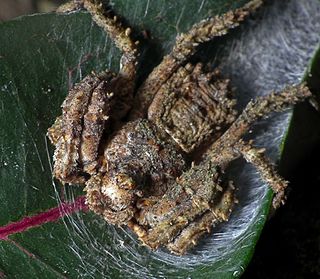
Stephanopis is a genus of crab spiders first described by Octavius Pickard-Cambridge in 1869. It was erected for five then newly described species, including S. altifrons, from Australia. Stephanopis was characterized by the high cephalic region with unequally sized anterior eyes disposed in a strongly recurved row, opisthosoma ending in several spiniform projections and dorsoventrally depressed habitus. According to Pickard-Cambridge, the single specimen used for the description of S. altifrons was dry-pinned. Therefore the specimen could not be properly examined, so it was not possible to determine if the specimen was adult. Moreover, he states his own sketch of the spider as “hasty”. This may explain why the somatic characters were inadequately described, genitalic features were not mentioned at all, and the illustrations were not detailed enough, making the species unidentifiable.
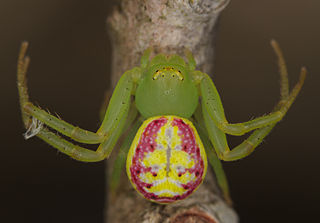
Tharrhalea is a genus of crab spiders first described in 1875 by Ludwig Carl Christian Koch.
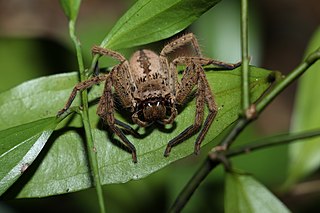
Beregama cordata, sometimes called the fire-back huntsman, is a species of spider endemic to Queensland and New South Wales, Australia. It is a member of the genus Beregama of huntsman spiders.

Beregama aurea, sometimes called the golden huntsman, is a species of spider endemic to Queensland and parts of New South Wales, Australia. It is a member of the genus Beregama of huntsman spiders.

















